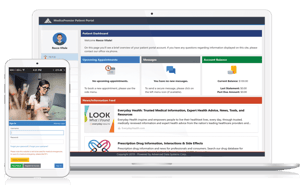Newsletter
Fall 2020
This edition of ADSvantage features articles on codes and coding, the Medics MyChart app
and the 21st Century Cures Act, COVID-19 and minimizing patient/staff contact,
and a few interesting industry news items.
CALLING ALL CODES!

We start this issue with two essential advisories on codes:
- ICD-10: new codes for ICD-10 were needed by 10/1. We alerted all ADS clients about ten days in advance that the codes were ready and available to be entered by us for clients. Updating was successfully completed.
- E/M Coding for 2021: the hottest coding subject right now involves the length of time of the encounter or the level of medical decision making (MDM).
Using the correct E/M codes starting January 1, 2021 will result in significantly increased revenue.
Codes apply to in-office and telemedicine sessions. Laboratories are not affected by this.
The good news is our EHR handles both length of time and MDM factors, ensuring claims are submitted through MedicsPremier with the best possible E/M codes. If preferred, the appropriate E/M codes can be entered by the operator on the claim in MedicsPremier as well.
Invitations to an on-demand 2021 E/M coding webinar will be emailed to all clients by mid-November.
- NCCI Edits Simplified: You know doubt already know the National Correct Coding Initiative calls for the bundling of component codes into their more inclusive codes in order to create one bundled claim. Component codes submitted as separate claims will be denied unless exceptions apply in specific billing scenarios.
- Correct bundling can be daunting with over one million editing possibilities, but our Medics NCCI Editor option works to ensure component codes are correctly incorporated into their inclusive codes resulting in cleanly-submitted single claims.
- Please email info@adsc.com if you’re interested in the Medics NCCI Editor.
ONC’s 21st Century Cures Act and Medics MyChart

The deadline to begin testing for the 21st Century Cures Act (CA) is now 12/31/21, with actual reporting to begin in 2022. Sounds like a long way off but as you know, in our collective worlds, 12/31/21 will be here quickly.
ADS is happy to report that we’re way ahead of the curve since the MedicsCloud EHR was already CA-enabled for stage 1’s original date of 11/2/20.
A new, noteworthy, ADS technology platform is Medics MyChart. Created to assist in compliance with the CA, it’s also ideal to use right now for keeping your patients healthy and connected.
Here’s how the SMART/FHIR-enabled MyChart works and the advantages it’ll bring to your setting:
- Providers simply register with their state’s HIE as a Trusted Data Sharing Organization (TDSO) You may want to do that in any case since there are usually additional benefits in being a TDSO provider.
- Your patients download the MyChart app onto their iOS or Android device.
- Using the MedicsCloud EHR, you create groups of patients based on a diagnosis that could lead to emergency room visits and hospital or facility admissions. That list is securely transmitted to the HIE which ingests it into their system, creating a master patient index in the process.
- You're automatically notified whenever those patients visit an ER and/or are admitted into a hospital or facility since those entities are HIE-monitored. The alert goes into the patient’s MedicsCloud EHR record as a “red flag” item.
- Because the HIE also monitors discharges, you’ll receive an alert as soon as the patient is discharged. Since the MedicsCloud EHR is tightly integrated with the HIE, the patient’s clinical data is inserted into the patient’s chart for expedited data entry and workflow.
- On discharge, you’re able to transmit appropriate questionnaires and messages through the MyChart app to the patient based on the admission reason. Messaging could include an advisory to come in for an appointment or to schedule a Medics Telemedicine session. The patient can be directed to schedule either appointment type through the Medics Portal.
You’re able to quickly grasp onto whatever follow-up healthcare interaction the patient needs, help prevent readmissions, and generate revenue, all at the same time.
MyChart addresses interoperability challenges by empowering patients to upload, share, and maintain their health data. It’s uncomplicated, requiring no more than basic smartphone usage.
Our initial version has the ability to connect with any open API as required by the Cures Act. The next version will enable patients to connect with CMS through CMS’s Blue Button FHIR interface to also check the status of their pending claims, or to check eligibility for preventative care visits.
Most state HIEs should be able to handle the MyChart platform, and should have TDSO registrations for providers.
Contact us at 800-899-4237, Ext. 1, or email info@adsc.com for more information on Medics MyChart, and contact your state’s HIE about TDSO registration.
Clinical Decision Support is Coming
The educational and operational testing requirements for using a certified CDS mechanism has been put off by CMS through CY 2021. The MedicsCloud EHR’s CDS option would’ve been ready for 2020, so it certainly will be for the next deadline, and with updated features as well.
We anticipate making it available mid 2021 giving clients ample time to work with and test it.
For our radiology clients: MedicsRIS is CDS-compatible right now and will be able to accept authorization codes from referrer’s EHRs as soon as the requirement is established.
COVID-19, Zero-Contact Intake, and Click-Free Encounters
 As of this writing, we see clients may be experiencing an uptick in in-office visits which will hopefully only increase daily. At the same time, telemedicine sessions remain at an all-time high.
As of this writing, we see clients may be experiencing an uptick in in-office visits which will hopefully only increase daily. At the same time, telemedicine sessions remain at an all-time high.
So, there’s a need for two things: (1) zero contact intake for in-office visits, and (2) quick and easy-to-use telemedicine.
ADS has iOS/Android platforms for both. Besides providing contactless, touchless interactions between patients and staff, these ADS solutions also drive revenue, patient engagement and connectivity, and enhanced experiences for all!
- MedicsPortal supports patients arriving for their in-office appointments with their intake paperwork and questionnaires completed by them in advance, anytime at their convenience, 24x7.
- It accommodates secure online copayments in advance and payments for past due balances, eliminating another time-consuming, face-to-face front desk routine.
- Even more, patients can fully or partially pre-pay their estimated balance after insurance amount based on the appointment reason when you use MedicsPremier’s built-in Patient Responsibility Estimator. .
- The Portal’s user-defined Notifyer sends reminders to patients about completing any new or outstanding questionnaires and/or about new information to read.
- Other Portal features include scheduling or requesting (your option) appointments anytime 24x7, a bi-directional “chat” feature, refills, information lookups, and a practice-defined ability for patients to self-edit demographics, insurance information, and more.
- MedicsKiosk: ideal for any last-minute items that need to be completed. iOS/Android-friendly, the kiosk also supports electronic signatures. A scanning option inputs data from drivers’ licenses and insurance ID cards directly into the patient’s record, simultaneously inserting the scanned image onto the record.
- Medics Telemedicine: is perhaps the ultimate zero-contact feature! Patients can use their devices to log into the session at the appointment time. Providers also enter the session and the encounter is on. The session is automatically timestamped for accurate billing through MedicsPremier.
- Based on your own financial policy, patients can pay for their sessions through the Portal in advance or on completing their sessions.
- Our remote patient vitals monitoring option is an ideal adjunct to Medics Telemedicine; it’s an excellent revenue generator, as is Medics Telemedicine!
- Click-Free, In-Office Encounters: while the encounter itself is a “no-escape” face-to-face situation, it’s made as efficient as possible when using our click-free, voice-driven MedicsCloud EHR.
- Navigating the EHR with voice commands eliminates having to tediously place cursors in the next field. And when using almost any transcription system such as Dragon Medical One, our built-in Medics FlowText completes the record as part of transcribing the report in one pass.
- So, the encounter becomes as efficient as possible with the MedicsCloud EHR and its built-in Medics FlowText enhancement.
- Side note: FlowText enables providers to use their iOS or Android devices from virtually anywhere globally to transcribe when using almost any transcription system. and transmit completed reports from the device to referrers.
Recap: ADS’s technology platforms enable you to operate in a world that calls for both social distancing and minimizing risk and exposure for in-office appointments, and for virtual telemedicine sessions.
Please contact us at 800-899-4237 Ext. 2264, or email info@adsc.com for more information on any of these features and options.
Medics Interactive Appointment Reminder Texting is not necessarily a technology piece for social distancing but it keeps patients tuned into their in-office or telemedicine appointments quickly enabling them to confirm or cancel simply by replying.
Aside from patients having occasional last minute emergencies, texting almost completely eliminates costly no-shows. And they’re ideal as balance due reminders. Patients can be directed to the portal to make their payments (see “Portal” above).
Medics Interactive Appointment Reminder Texting will work to keep your schedule tight and revenue optimized.
Industry News
 A Hacker with a Heart: We don’t want to mention names, but a prominent PA-based, non-profit human services agency that provides assistance to people with intellectual disabilities, autism, and behavioral health needs, had its system hacked-into.
A Hacker with a Heart: We don’t want to mention names, but a prominent PA-based, non-profit human services agency that provides assistance to people with intellectual disabilities, autism, and behavioral health needs, had its system hacked-into.
Once inside the system, the hacker was able to see the work this agency does and felt badly about completing the mission. In fact, the hacker let the agency know through their website’s “contact us” form that they were able to get in, and that the agency needed greater protection!
The warning was heeded and security overhauls were put into place. The agency also correctly reported the intrusion as a breach to law enforcement, to their cyber insurance carrier, and to HHS who in turn notified state regulators and the 25,000 individuals potentially affected.
An interesting side note reports how hackers can have that kind of moral dilemma once they’re into the targeted system and see the data. It’s rare, but it happens.
Takeaway
You can’t trust that your hacker will have a heart. And even if he or she does, you’d still have to make the notifications as this agency did.
- Clients on our ADS cloud have the protections in place needed to prevent the ominously-named threats you’ve heard of, including malware, spyware, phishing, and the worst of all, ransomware. We also ensure your backups are current and secure.
- Even so, we strongly suggest that all of your local workstations and devices have the latest protections and firewalls installed and that your local operating system isn’t outdated and no longer supported by Microsoft.
- Contact the ADS IT Team at 800-899-4237, Ext. 1 or email info@adsc.com if you have questions.
- Clients with their ADS systems on their own servers must ensure all of the protections and firewalls needed against intrusion are securely in place on their server and on every workstation and device connected to the server.
- You must also be diligent in performing backups regularly, making sure your backup media are stored securely should a data restore be needed.
- Contact the ADS IT Team as noted above if you have any questions on your current customer-hosted Medics system.
- If you’d like to know more about transitioning to the ADS cloud, give us a call at 800-899-4237, Ext. 2264 or email info@adsc.com.
COVID-19 and Physicians Revenue is an Assorted Landscape

We’ve lived through how coronavirus has created sharp decreases in in-office appointments, especially for those not of a critical nature such as well visits and annual checkups. Appointments involving elective and, to some degree, even non-elective procedures that could wait were being canceled and rescheduled for dates in the future, often more than once for the same patient.
Specialties such as plastic surgery, dermatology, ophthalmology, orthopedic surgery, gastroenterology, and general and vascular surgery were most affected by putting off non-electives and surgeries where patients could get by without them for right now.
Primary care physicians have been hurt most with routine office appointments for annual checkups and well visits, for example, being canceled.
Some specialties report that income has been holding up to some degree. These include urology, ob/gyn, radiology (especially with an increase in coronavirus-related readings and how direct patient contact is basically nonexistent), anesthesiology (unless a majority of the anesthesiologist’s cases are for elective surgeries), psychiatry, cardiology, and neurology.
Specialties that COVID-19 may have affected only slightly, if at all, are neurosurgery, cardiac surgery, and oncology. These are also higher priority specialties in terms of having access to personal protective equipment (PPE) and operating space.
Along with that, the top five specialties for treating coronavirus, according to MedScape, are emergency medicine, nephrology, critical care, infectious disease, and pulmonology.
Spoiler alert: if you want to mull over what you think are the two specialties or better – segments – (there’s a hint) that have flourished financially because of COVID-19, stop here.
Ready?
One is concierge medicine. More and more patients are seeking direct, on-demand access to physicians for which they pay a monthly or yearly fee, particularly since concierge medicine physicians can have access to and are providing tests.
The second segment are telehealth physicians. Two major telehealth companies report rises of 70% and 153% in tele-visits since March 2020.
Telemedicine stats shouldn’t be surprising. You know its advantages: remote encounters generate revenue while keeping patients engaged and connected. It’s the ultimate in healthcare social distancing. (Reminder that Medics Telemedicine can easily accommodate your sessions and automatically timestamps them for accurate billing!)
Click here for the report.
Coronavirus = Consumerism
 Patient interest in price transparency is at an all-time high. COVID-19 may have a hand in that, most notably stemming from the financial and economic fallout caused by it. An onus has been placed on payers and providers to support price transparency.
Patient interest in price transparency is at an all-time high. COVID-19 may have a hand in that, most notably stemming from the financial and economic fallout caused by it. An onus has been placed on payers and providers to support price transparency.
Along with that is how CMS calls for hospitals to have transparent pricing information available to patients in advance in 2021.
Interestingly, the report also delved into patient responsibility amounts. It stated how 60% of patients said they’d be at least somewhat more likely to pay their after-insurance balances up front, knowing what they’d owe in advance, and how 65% said they’d likely make a partial payment in advance.
(The patient responsibility estimator in MedicsPremier can provide a close approximation of what the patient will owe based on the appointment reason. It can be accessed by the system operator while scheduling the appointment or any time before the appointment.
It can then display a more finely-tuned amount before the patient leaves, empowering you to capture patient responsibility amounts, either fully or partially.)
Additional Resources
 MIPS 2020, Continued
MIPS 2020, Continued
MIPS continues forward for 2020. Since there’s a lot of content, please click here for details. (Our MedicsCloud EHR is excellent for compiling the needed data.)
ADS Learning Center
Reminder that articles, videos, webinars, system information, and items of interest can be seen by visiting the ADS Learning Center.
Next Up
ADSvantage Winter 2020. As always, we’ll send any advisories separately as needed.
Disclaimer: not all system features described may be compatible with your particular version of Medics. Contact ADS support if clarification is needed as to your version. Articles and content on governmental information (e.g., CMS, Medicare, Medicaid, MACRA, MU, CDS, etc.) are presented according to our best understanding of them. www.cms.gov or other reliable websites should be consulted, or any organization(s) should be contacted directly for details or if clarifications are needed. ADS is not responsible for any typographical errors or for changes that may occur after this newsletter was produced. Visit www.adsc.com to view our most up-to-date information.
Request More Information
Copyright © Advanced Data Systems Corporation. All Rights Reserved. Legal Notice | Trademarks
